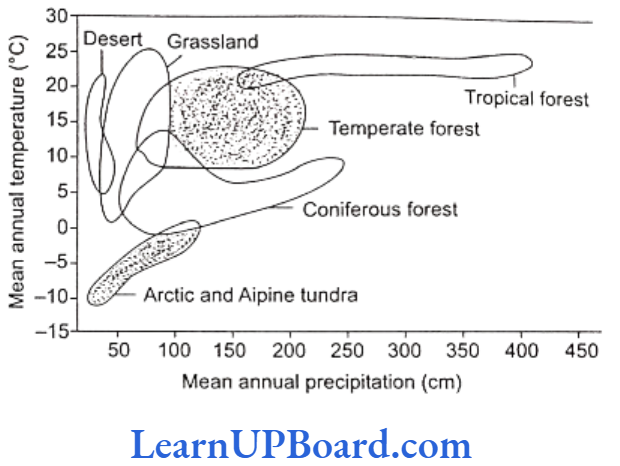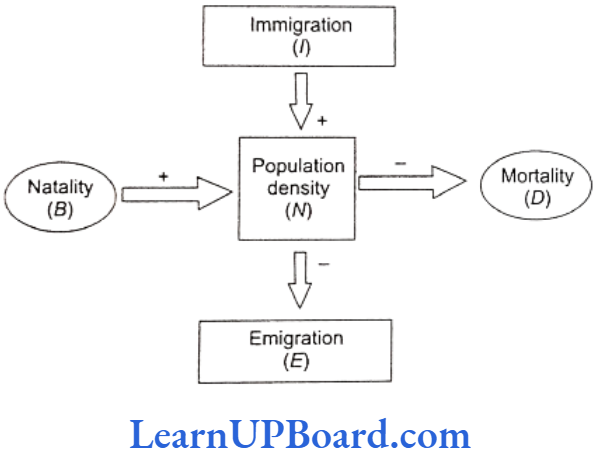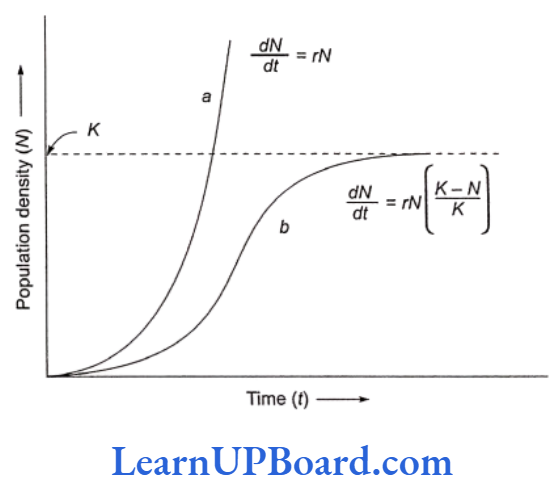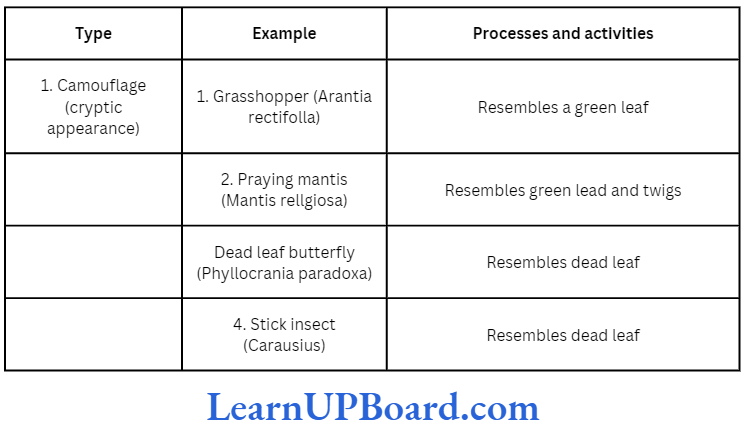NEET Biology Notes PDF Free Download
NEET Biology Notes For Organisms And Populations
Habitat: A specific place (or locality) where an organism usually lives. It is a physical entity comprising the sum total of the abiotic factors to which a species or a group of species is exposed.
Ecological niche (J. Grinnel): It represents the functional role and status of a species in the environment. It represents habitat and trophic level of a species. No two species can have the same niche even if they are found in the same environment
Read and Learn More NEET Biology Notes
Population: A group of individuals of the same species in a well-defined geographical area which share or compete for similar resources and can potentially interbreed. Their study links ecology to genetics and evolution of a population.
Community: A number of interrelated populations of different species sharing a common environment.
Ecosystem: A functional unit of nature in which living organisms interact with one another and with their surrounding physical environment.
Biosphere: Any part of atmosphere inhabited by organisms.
Ecology deals with the various principles which govern the relationships between organisms and their environment. The term “ecology” was first used by Reiter in 1868. Ernst Haeckel (1886) first correctly defined ecology as the science dealing with reciprocal relationship of organisms and the external world. Warming (1895) employed this science for the study of plants. E.P. Odum (1963) defined it as the “study of structure and function of nature.”
Clarke, Warming, Weaver, Clements, Schimper, Dauben-malre, Raunkiaer, E.P. Odum, and H.T. Odum are some renowned ecologists. Prof. R. Misra is known as the “Father of Ecology in India.” Other famous Indian ecologists include G.S. Puri and S.C. Pandeya. Ecology gives a holistic perspective to biology.
NEET Biology Notes For Organisms And Populations Branches Of Ecology
- Autecology: Ecology of individuals or species, essentially physiological ecology.
- Synecology: Study of relationships between communities and environment.
- Genecology: Study of ecological adaptations in relation to genetic variability.
- Paleoecology: Study of relationship between organisms and environment in the past.
- Applied ecology: Application of ecological concepts for human welfare.
- Systems ecology: Interpretation of ecological concepts in terms of mathematical principles.
“population of organisms “
NEET Biology Notes For Organisms And Populations Organisms And Their Environment
Environment is the sum total of all external factors, substances, and conditions which influence organisms without becoming their constituent part. Environment is usually divided into two parts: physical environment and biotic environment.
Factors such as components, conditions, and forces of environment which have a direct and indirect effect on the form, functioning, behavior, survival, and reproduction of organisms are called environmental factors. These are of two types: abiotic and biotic. Abiotic factors are divisible into three categories: atmospheric, edaphic, and topographic. Atmospheric factors are light, temperature, water, and wind. Edaphic factors are related to soil. Topographic factors are abiotic or physical factors related to slope, altitude, etc., connected with the surface behavior of the earth. Biotic factors are influences produced by living organisms.
NEET Biology Notes For Organisms And Populations Biome (Major Ecosystems)
A biome is a large natural ecosystem which is distinct in its climatic conditions and has its specific group of climax plants and associated animals. Rainfall, temperature range, nature of soil, barriers, latitude, and altitude determine the nature and extent. of biomes.
The major biomes of India are as follows:
- Tropical rain forests: In India, tropical rain forests are found mainly along Western Ghats and in north-eastern Himalayas. Dipterocarpus and hopea are the most common tree species in Indian rain forests. They show a 30-40 m tall canopy with four-five strata. Woody climbers and epiphytes grow profusely in these forests. The soil of such forests is highly leached and has a low base content. They require a mean annual temperature of 23-27 °C and 2000-3500 mm rainfall.
- Tropical deciduous forests: They occur in the northern and southern parts of our country in plains and low hilly areas. Sal, teak, and tendu are the common trees of these forests. These forests show a short structure of 10-20 m. During rainy season, the forest is lush green with dense foliage, whereas in summer, the forest is largely leafless. The soil of these forests is rich in nutrients due to less leaching. They require a mean annual temperature of 22-32°C and mean annual rainfall of 900-1600 mm.
- Desert: In these biomes, vegetation is very sparse due to extreme temperatures and very little rainfall (below 10 cm). Hot deserts are characterized by high rate of evapotranspiration and albedo. In cold deserts, the conditions are physiologically xeric and they exhibit permafrost, while in hot deserts, the conditions are physically xeric. Important trees of Indian desert are Prosopis cineraria, Acacia sp., Salvadora sp., and Tamarix sp. The common succulents are species of Euphorbia and many members of family Cactaceae.

- Coastal biome: Coastal areas are zones of transition between oceanic and terrestrial habitats and, so, are very sensitive. These are detritus-based biomes, where plants have to adapt to salinity and water-logged conditions. Mangroves are the major types along salt marshes or swamps. Mangroves are characterized by the presence of pneumatophores and viviparous seed germination. Common examples are Rhizophora, Sonneratia, Avicennia, and Laguncularia. Besides, Phoenix, Pandanus, and Casuarina are also found commonly in coastal areas.
NEET Biology Notes For Organisms And Populations Response To Abiotic Factors
A change in one environmental factor leads to change in others also. In other words, all factors are integrated. An organism would have evolved various mechanisms to maintain its internal environment at homeostasis to perform its physiological and biochemical functions. This constancy is necessary for its overall fitness or maximum performance. This may be maintained naturally or artificially.
” basic functional unit to study the ecology is termed as”

- Regulate: All birds and mammals and a few lower vertebrates and invertebrates maintain homeostasis by physiological or behavioral means such as thermoregulation and osmoregulation. But plants do not have such mechanisms to regulate homeostasis. The evolutionary success of mammals is believed largely due to this ability.
- Conform: When organisms cannot maintain thermal and osmotic balance with their environment, they adopt this mechanism, e.g., approximately 99% plants and animals. Thermoregulation is energetically expensive, especially for small animals having large surface area relative to their volume. Due to this, very small animals are rare in polar regions. Some species have the ability to regulate up to a limited range beyond which they become conform (partial regulators).
For localized or short outburst of stressful conditions, organisms show migration or suspended growth. - Migrate: It is the temporary movement of organisms from a stressful area to a more favorable one in terms of food, shelter, spawning, or climate. For example, Siberian cranes migrate from Siberia to Keoladeo National Park, also known as Bharatpur Bird Sanctuary, in Rajasthan. Locums migrate for food and salmon fish migrates for spawning. Similarly, ungulate’s migration in Africa takes place for food.
- Suspend: It is a stage in the life cycle of organisms where they change their developmental/physiological structural/biochemical behavior to pass through unfavorable conditions. Examples are thick-walled spores in bacteria, fungi, and lower plants; dormancy in seeds and other vegetative parts in higher plants; and hibernation (winter sleep) among organisms which are un- able to migrate, e.g., bears.
- Aestivation: It is the metabolic inactivity of organisms during hot desiccating summer, e.g., snails and fish.
- Diapause: It is the stage of temporary suspension of development under unfavorable conditions, e.g., zoo- plankton in lakes and ponds.
Adaptation
Adaptation is an attribute of an organism that enables it to survive and reproduce in its habitat. Adaptations may be morphological, physiological, or behavioral. These are either fixed genetically or remain epigenetic.
Some examples of adaptation are as follows:
- The kangaroo rat of North American desert fulfills its water demands by internal oxidation of fats. It also has the ability to concentrate its urine.
- Mammals from a colder climate generally have shorter ears and limbs to minimize heat loss. Here, Allen’s rule is at work.
- Seals have a thick layer of fat (blubber) below the skin to reduce loss of body heat.
- Altitude sickness can be expressed at high altitudes where body does not get enough oxygen due to low atmospheric pressure, causing nausea, fatigue, and heart palpitations. Under these conditions, the body increases RBC production, decreases the binding capacity of fibrils, and increases breathing rate. These physiological adaptations allow organisms to respond quickly to stressful conditions.
- Archaebacteria can flourish at a temperature exceeding 100°C, while humans can perform metabolism in a narrow range (37°C).
- Antarctic fishes can survive below 0°C, and a variety of invertebrates and fishes are adapted biochemically to survive great depths with crushing pressure.
- Desert lizards lack the physiological ability to cope with extreme temperatures, but manage the body temperature by behavioral means.
Water-Based Adaptations
On the basis of dependence of plants on water and their relationship with water, Warming (1909) recognized three kinds of plant communities: hydrophytes, xerophytes, and mesophytes.
Hydrophytes: They live in abundance of water with at least their lower parts (roots) and leaves submerged.
Roots of hydrophytes are poorly developed/completely absent in Wolffia, Ceratophyllum, etc.
- Stems in hydrophytes are of three kinds:Reduced in free floating plants (e.g., Pistia).
- Narrow and slender in submerged, suspended plants (e.g., Hydrilla and Ceratophyllum).
- Well-developed in amphibious plants and rhizome growing through the mud (e.g., Nymphaea and Typha).
Leaves in hydrophytes are of the following kinds:
- Usually long ribbon-like (e.g., Potamogeton) or finely divided (e.g., Ranunculus).
- In some hydrophytes, leaves of different forms are produced by the same plant-aerial leaves are not dissected but submerged ones are dissected (e.g., Ra-nunculus aquatilis and Limnophila. This is known as heterophylly.
- Petioles become long, swollen, and spongy (e.g., Nymphaea, Nelumbo, and Saggitaria).
Hydrophytes show the following anatomical adaptations:
- There is no cuticle over the epidermis.
- Stomata either are absent or are dysfunctional.
- Aerenchyma is well developed.
- Epidermal cells contain chloroplasts.
- Mechanical tissues such as sclerenchyma and collenchyma are poorly developed.
- Vascular tissues are poorly developed,
- Secondary growth is absent.
- Vegetative propagation is common by runners (e.g., Marsilea), offsets (e.g., Pistia and Eichhornia), rhizomes (e.g., Typha), and turions (fleshy buds, e.g., Potamogeton).
- Xerophytes: These plants show anatomical and physiological adaptations.Anatomical adaptations: Thick-walled epidermal cells, multiple epidermis (e.g., Nerium), thick cuticle, hypodermis sclerenchymatous, stomata sunken and covered by hair (e.g., Nerium, Casuarina, and Ephedra), water storing parenchyma well developed, conducting and mechanical tissues well developed, palisade multilayered, and cells of succulents contain abundant mucilage.
- Physiological adaptations: Reduction of transpiration, high osmotic potential, and resistance to desiccation of mucilage to hold water.
On the basis of the nature of soil and causes of unavailability of water, xerophytes are divided into the following categories:
- Physical xerophytes: These plants grow in soils. which are physically dry (due to shortage of water), e.g., Opuntia, Casuarina, Ruscus, Muehlenbeckia (Coccoloba), etc.
- Physiological xerophytes: These plants grow in soils having sufficient water which is not available due to high salt concentration (salinity) or very low temperature.
On the basis of life cycle and water storage, xerophytes are divided into the following categories:
- Ephemerals: These plants are short-living, i.e., have a brief lifespan (6-8 weeks). These evade dry season by disappearing, leaving behind their seeds. Hence, these plants are not true xerophytes, rather drought evaders and drought escapers, e.g., Cassia tora and Tribulus.
- Succulents (fleshy xerophytes): These plants absorb a large quantity of water during rainy season and store it in different body parts. These suffer only externally. Hence, these are drought avoiding or drought-resistant xerophytes. These are further divided into the following:
- Stem succulents: e.g., Opuntia, Euphorbia antiquorum, E. splendens, E. tirucolli, and Cereus.
- Leaf succulents: e.g., Aloe, Agave, Begonia, and Bryopnyiium.
- Root succulents: e.g., Asparagus and Hebe parviflora.
- Nonsucculents: These plants are drought endurers and true xerophytes, and can withstand long drought periods (perennial nonsucculents), e.g., Casuartna, Zizyphus, Nenrium, Calotropis, Acacia, and Capparis.
Halophytes: Halophytes are special types of xerophytic plants which grow in saline soils with high concentrations of salts such as NaCl, MgCl2, and MgSO (hence, physiologically dry soil). Halophytic communities growing on swamps are called halophytes.
” organisms and population class 12 ppt “
NEET Biology Notes For Organisms And Populations For Population
Population is of two types. One is called deme, which stands for local population living in a specific area. The other is meta population, which consists of the whole set of local populations connected by dispersing individuals.
For the purpose of ecological studies, a group of individuals resulting from asexual reproduction is also considered population.
Population Attributes/Group Attributes
Some characteristics are unique to the group and are not the characteristics of the individuals forming it; for example, an organism is born and dies, and has a specific age, but it does not have birth rate, death rate, and age ratio.
Population characteristics can be best expressed by statistical methods. Some important characteristics are discussed next.
Population Density
Density is the number of individuals per unit area; e.g., millions of Spirogyra filaments in a pond or 200 Parthenium plants in an area. This can also be expressed as “the population biomass per unit area or volume” when we have to count a large number of organisms or find out the role of a single huge banyan tree in an area.
Relative density is a good measure of finding out the total density of fishes in a lake by counting the number of fishes caught per trap. Another example of measuring the size of a population is tiger census in India. This census is based on pug marks and fecal pellets which are used to indirectly estimate the population size of tigers.
Age Ratio Pyramids
An age pyramid is a graphic representation of the proportion of various age groups in a population. There are three types of age pyramids: triangular, bell-shaped, and urn-shaped.
Triangular pyramid: It is the graphic representation of a young or growing population and has a very high proportion of pre-reproductive individuals.
Bell-shaped pyramid: The pyramid is bell-like with pre-reproductive individuals only marginally more than the reproductive individuals. The population is mature or stable.
Urn-shaped pyramid: It has a small number of pre-reproductive individuals, a larger number of reproductive individuals, and a small number of post- reproductive individuals. Such a population shows negative growth.

Population Growth
Some attributes of population are used to estimate its growth as population size may fluctuate in a given habitat in a given period due to changes in the four basic processes discussed as under.
- Natality: It is the birth rate (an inherent ability of a population to increase) and refers to the number of births in the population during a given period that are added to its initial density.
The per individual change in a population due to natal- ity can be estimated using AN/Nat,
where AN, is the number of new individuals produced, Nis the initial population, and At is the change in time. - Mortality: It is the death rate (the number of individual dying in a population in a given period).
- Immigration: It is one-way permanent inward movement of individuals of the same species into a habitat with existing population. This may help to speed up the growth or prevent extinction of a smaller population. In plants, it is a settlement of disseminules.
- Emigration: It is one-way permanent outward movement of a number of individuals from a population to other habitat area, hence, reducing the size of that local population. Plants are fixed and, so, do not show emigration.
By these population characteristics, the density of a population (M) at time t can be expressed after a period of time t+1 as
N(+1) = N; + [(B + 1) − (D + E)]
where B is the number of births, I is the number of immigrants, D is the number of deaths, and E is the number of emigrants.

So, it can be concluded that births and deaths are the most important factors influencing population density.
Growth Models
Biotic potential and environmental resistance: Biotic potential (r) is the maximum or potential natality. The sum of environmen- tal factors that limits the population size is called environmental resistance. Environmental resistance rises with the rise in popula- tion size. The influence of environmental resistance over biotic potential is denoted by (K – N)/N.
Carrying capacity (K): The maximum number of individuals of a population which can be supported with optimum resources for their survival is called the carrying capacity of the environment. The growth of a population depends on its biotic potential, death rate, and birth rate. Depending upon the amplitude of these three, a population may show exponential growth and logistic growth.
- Exponential growth: Darwin believed a population grows geometrically when the resources are unlimited, as each species realizes its inherent potential to grow. This intrinsic rate of natural increase is called r. The value of r is an important parameter to assess the impact of environmental factors on population growth.
- Any increase or decrease in a population N during time t (dNidt) will be dN/dt = (b-d) x N, where b is the per capita birth rate and d is the per capita death rate. If (bd) = r, then, dN/dt = rN.
- The magnitude of r was 0.0205 for human population in India, while it reached 0.0176 in 2001. For Norway rat, it is 0.015 and for flour beetles, it is 0.12.
- Equation dN/dt = rN describes geometric growth resulting in a J-shaped curve. Such population stops abruptly due to environmental resistance, which suddenly becomes effective, or depletion of a resource. Decline in a J-shaped population is density-triggered, e.g, algal blooms insect population.
” class 12 organism and population notes”

- Logistic growth: This growth form is characterized by a function of carrying capacity (K) for a given population, giving it a more realistic form. Such forms are represented under limited resource conditions, where a population finally reaches an asymptote. This growth form can be described as the Verhulst-Pearl logistic growth and is expressed as
dN/dt = rN(K-N/K)- Life history variation: Any variation in life history is evolved in relation to the selection pressure imposed by environmental factors in order to achieve the most efficient reproductive strategy such as the following:
- A small number of large-sized individuals are produced (e.g., mammals and birds).
- A larger number of small-sized individuals are produced (e.g., oysters and fishes).
- Some organisms breed once in their life time (e.g., Bambusa and Pacific salmon).
- Some organisms breed many times during their life-time (e.g., mammals and many birds).
- Life history variation: Any variation in life history is evolved in relation to the selection pressure imposed by environmental factors in order to achieve the most efficient reproductive strategy such as the following:
Population Interactions
Many populations of different species may require a similar set of environmental gradient where they live and interact with each other and environment in order to survive and perform their activities. These interactions may be assigned “+,” “_” or “0,” where “+” is beneficial, “-” is detrimental, and “0” is neutral.
- Negative interactions: These are interactions between two species where one species affects others’ growth and survival.
- Competition: It is a process in which the fitness (r) of one species is significantly lower in the presence of other species.
- Competition affects plants and herbivores more than carnivores.
- This may occur between totally unrelated species when they compete for the same resource, e.g., competition for zooplankton between visiting flamingoes and resident fishes in South American lakes.
- Resources need not be limiting for competition to occur; the feeding efficiency of one species might be reduced due to the inhibitory or interfering presence of other species.
According to Gause’s competitive exclusion principle, two closely related species competing for the same resources cannot coexist indefinitely and the competitively inferior species will be eventually eliminated. Gause performed his experiments on two species of Paramecium: P. aurelia and P. caudatum.
Coexistence: Species facing competition might evolve a mechanism to live in the same niche by changing the feeding time or foraging patterns. This is called resource partitioning. For example, five closely related species of warblers avoid competition by changing their foraging pattern..
Habitat diversification can also reduce competition, e.g., Tribolium and Oryzaephilus. Tribolium Trifolium model best explains both exclusion and coexistence. There are some circumstantial evidences which support the exclusion of species due to competition. For example,
- Introduction of goats resulted in the exclusion of Abingdon tortoise from Galapagos Islands.
- The same interaction occurs between Balanus and Chthamalus on the rocky coasts of Scotland.
Competitive release: There occurs a dramatic increase in the population of a less distributed species in a geographical area when its superior competitor is removed experimentally from that area.
Predation: It is an interaction between species involving killing and consumption of prey.
Predation plays the following roles:
- Transfer of energy (in ecological sense, herbivores are not very different from predators).
- Keeping prey population under control.
- The rabbit population in Australia increased tremendously because the land does not have its natural predators. The introduction of prickly pear cactus (Opuntia) in Australia was controlled only after the introduction of its natural predator moth (Cactoblastis cactorum). Similarly, red foxes in New Zealand have become top carnivores due to the absence of a natural carnivore.
- Predators help maintain species diversity in a community as they can reduce the intensity of competition among prey species; e.g., experimental removal of Pisaster (star fish) resulted in the extinction of more than ten species of invertebrates.
- According to the Slobodkin’s principle of prudent predator, a predator does not exterminate its prey by overexploitation.
For their defense, prey species have evolved various adaptations, which are listed as follows:

- Monarch butterfly is well known for its general unpalatability to its predator birds. This insect is able to sequester highly toxic glycosides present in milkweeds on which its caterpillar stages feed. There larvae develop on milkweed providing the protection to plant against herbivory.
- Cardiac glycosides are produced by Calotropis. Nicotine, caffeine, quinine, and strychnine are other means of chemical defense in plants.
- The association of bullhorn Acacia cornigera with Pseudomyrmex ferruginea (acacia ant) is a defense against herbivory. This is also an example of coevolution.
Parasitism: This also depresses the growth rate of a population or may reduce the total size of the population. Parasites are generally smaller. Majority of them are host-specific. A high reproductive potential, loss of digestive system and unnecessary sense organs, and the presence of specific sucking or adhesive organs are some of their characteristics, but they have poor means of dispersal.
Various types of parasites are given as follows:
- Ectoparasites: Examples are lice on humans, ticks on dogs, copepods on marine fishes, and Cascuta on hedge plants.
- Endoparasites: These are extremely specialized parasites, with a complex life cycle but simplified morphologically and anatomically. Examples are liver fluke, plasmodium, etc.
- Brood parasitism: An example of this type of parasitism is cuckoo which lays its eggs in a crow’s nest.
- Hyperparasites: Examples are bacteriophages, which are parasite over parasitic bacteria. Similarly, Pasteurella pestis is a parasite of rat flea, which is a rat parasite.
- Amensalism (-, 0): It is both a detrimental and a neutral relationship, where chemical secretion by one organism inhibits the growth of the other. Examples are allelopathic plants such as Prosopis juliflora and black walnut.
Positive interactions: It is an association between two species where one or both populations realize positive effects. This is necessary to achieve homeostasis.
Commensalism (+, 0): It is the simplest form of interaction, in which one species is benefitted while the other is neither harmed nor benefitted. Examples are orchid epiphytes on mango trees, cattle egret and grazing cattle, barnacles growing on the back of a whale, clown fish and sea anemone, and pilot and sucker fish with shark.
Mutualism (+, +): It is an obligatory relation where both species are benefitted. It is essential for their survival on the earth. Examples are mutualistic N2-fixing relation, lichens, mycorrhiza, termite-intestinal flagellate relation, and plant-pollinator relation. Sometimes, it is a one-to-one coevolution- ary relation such as fig and wasp relation, Ophrys and Colpa relation, and Yucca and Pronuba relation.
Some insects such as queens of Bombus affinis cheat plants to steal nectar from the spurs of Aquilegia.
Proto-cooperation (+, +): It is a nonobligatory relation where organisms of both species are benefitted. Examples are oxpecker and rhinoceros, and plover bird and crocodile.
NEET Biology Notes For Organisms And Populations Question And Answers
In the following questions, a statement of Assertion (A) is followed by a statement of Reason (R).
- If both Assertion and Reason are true and the reason is the correct explanation of the assertion, then mark (1).
- If both Assertion and Reason are true but the reason is not the correct explanation of the assertion, then mark (2).
- If Assertion is true but Reason is false, then mark (3).
- If both Assertion and Reason are false, then mark (4).
Question 1. Assertion: Holistic approach explains the environmental interactions.
Reason: All environmental factors are integrated with no limits of time and space.
Answer. 3. If Assertion is true but Reason is false, then mark (3)
Question 2. Assertion: Some organisms can maintain internal homeostasis by means of physiological processes and are called “regulates.”
Reason: Regulates can maintain internal homeostasis only up to a limit under stressful conditions.
Answer. 3. If Assertion is true but Reason is false, then mark (3)
Question 3. Assertion: Population ecology is a link of ecology to population genetics and evolution.
Reason: Natural selection operates at population level to evolve the desired traits.
Answer. 1. If both Assertion and Reason are true and the reason is the correct explanation of the assertion, then mark (1).
Question 4. Assertion: Under unlimited resource conditions, a population can show an exponential growth curve.
Reason: The maximum possible number of individuals can always be supported when enough resources are available.
Answer. 2. If both Assertion and Reason are true but the reason is not the correct explanation of the assertion, then mark
Question 5. Assertion: Insects contribute the maximum to the total diversity of animals.
Reason: Angiosperms and insects are coevolved to perform as plant-pollinator.
Answer. 1. If both Assertion and Reason are true and the reason is the correct explanation of the assertion, then mark (1).
